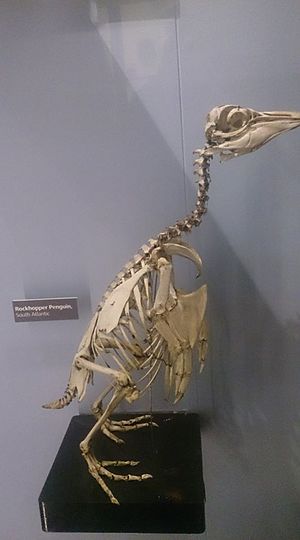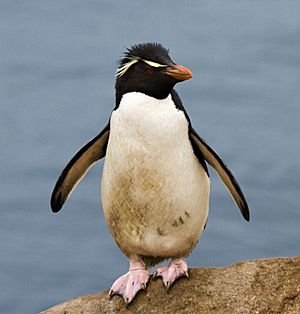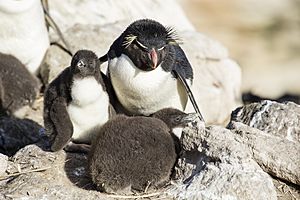Rockhopper penguin facts for kids
The rockhopper penguins are three types of crested penguins that look very similar. For a long time, people thought they were all the same species. Now, most scientists agree that there are at least two, or even three, different species.
Some experts believe all three are separate species. Others group the western and eastern types together as the southern rockhopper penguin, keeping the northern rockhopper as its own species. A few still think they are all just one species called the 'rockhopper penguin'.
- Western rockhopper penguin, Eudyptes chrysocome chrysocome
- Eastern rockhopper penguin, Eudyptes chrysocome filholi
- Northern rockhopper penguin, Eudyptes moseleyi
These penguins have a special crest of feathers on their heads. They are called "rockhoppers" because they jump from rock to rock to reach their nesting spots. They keep both feet together, allowing them to jump over a metre high!
Even though rockhopper penguins used to be one of the most common penguins, their numbers have dropped by almost 90% since the early 1900s. Scientists are not completely sure why this is happening. They think human activities might be involved, like too much overfishing, oil exploration, and pollution.
Contents
What Rockhopper Penguins Look Like
Rockhopper penguins are among the smaller types of penguins. They grow to be about 50 centimetres (20 inches) tall when fully grown. Males are usually a bit bigger than females. It's hard to tell males and females apart just by looking at them. Scientists often do a DNA test using a feather to find out their gender.
Like many penguins, rockhoppers have a white belly and a black back. But they have some unique features! They have bright red eyes, an orange beak, and pink webbed feet. Their most noticeable feature is the spiky yellow and black feathers on their heads. Young rockhopper chicks don't have these spiky feathers; they grow as the penguins get older. Their beaks also start black and turn orange as they mature.
Because they live in harsh, rocky places, rockhopper penguins cannot slide on their bellies like some other penguins. Instead, they hop to move around.
Different Types of Rockhopper Penguins
What makes rockhopper penguins different types (or subspecies) is where they live and how they behave when they reproduce. For example, the way southern rockhopper penguins (E. chrysocome) and northern rockhopper penguins (E. moseleyi) communicate during mating is very different. These differences happened quickly and are enough to keep these groups separate.
Southern rockhopper penguins are divided into two main groups based on where they lay their eggs.
- The E. c. filholi (eastern) type breeds on islands in the sub-Antarctic. These include the Prince Edward Islands, Crozet Islands, Kerguelen Islands, Heard Island, Macquarie Island, and Campbell, Auckland, and Antipodes Islands.
- The E. c. chrysocome (true southern) type breeds on islands off southern Chile, Argentina, and the Falkland Islands. The Falkland Islands are home to one of the largest groups of Southern Rockhopper penguins.
Here are the different types:
- Southern rockhopper penguin, Eudyptes (chrysocome) chrysocome
- Eastern rockhopper penguin, Eudyptes (chrysocome) filholi
- Northern rockhopper penguin, Eudyptes (chrysocome) moseleyi
Where Rockhopper Penguins Live

Northern rockhopper penguins live in cooler areas. They breed on islands like Gough and Tristan de Cunha in the Atlantic Ocean, and St. Paul and Manchester in the Indian Ocean.
Southern rockhopper penguins breed on the Falkland Islands, Argentina, and Chile. They also have breeding colonies around Cape Horn in South America. In the southern Indian Ocean, they are found on Prince Edward, Marion, Crozet, Kerguelen, Heard, Macquarie, Campbell, Auckland, and Antipodes Islands.
Eastern rockhopper penguins are mostly found breeding on Campbell Island in New Zealand. Sadly, their numbers there have dropped a lot.
Rockhopper penguins usually make their homes on rocky shorelines. They build nests and burrows in tall grasses called tussocks.
What Rockhopper Penguins Eat
The rockhopper penguin’s diet mainly consists of krill, which are tiny shrimp-like creatures. They also eat small crustaceans like shrimp, crabs, lobsters, or crayfish. Sometimes, they eat squid and small fish called myctophid fish.
Rockhopper penguins eat more krill than fish. Their diet can change depending on the season and when they are migrating. When hunting for food, rockhopper penguins can stay at sea for several days. They can dive up to 100 metres (330 feet) deep and stay underwater for many minutes while looking for prey.
Reproduction and Life Cycle
Rockhoppers are the most widespread type of crested penguins. They live in a large area, from the Antarctic front to the South Atlantic and Indian Oceans. Because they are so widespread, their breeding habits can be a bit different depending on where they live. For example, Northern Penguins start their mating process two months earlier than Southern ones.
Female rockhoppers usually lay two eggs a few days apart, typically in early November. They hope that at least one chick will survive. The second egg laid is usually larger than the first. They will often use the same nest they used in previous years. The eggs hatch about a month later. Once the chicks hatch, the mother will bring them food.
Images for kids
-
Southern rockhopper penguin, Eudyptes (chrysocome) chrysocome, New Island, Falkland Islands
-
Northern rockhopper penguin, Eudyptes (chrysocome) moseleyi
-
Eastern rockhopper penguin, Eudyptes (chrysocome) filholi






